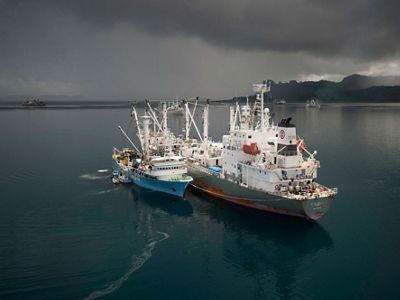
The ocean is incredibly complex- it spans from the very large, to the infinitesimly small, and we’ve discovered only about 10% of what it has to offer. Yet the little we know is already of incredible value to humankind; and we have been making use of it, for better, but often for worse.
As our use of the ocean intensifies- underpinned by dynamics like population growth, industrialization, and growing tourism- new and increased stressors are affecting both ocean and people. For example, development pressures in coastal waters for aquaculture, tourism and renewable energy create spatial conflicts; and both small scale and industrial fisheries struggle to balance resource extraction with resource protection. The cumulative effects of human activities in the ocean, combined with climate change impacts, point to ongoing and new threats to ocean health.
Donate: Help Protect Our Oceans and Coasts
Updated management frameworks and governance structures are essential to ensure that coastal communities and nations continue to thrive alongside a healthy ocean. To this end, marine spatial planning (MSP), a process which brings together different ocean users to make informed and coordinated decisions about how to use ocean resources sustainably, provides governments, local communities, and marine industries with a transparent, equitable and participatory processes to navigate these challenges, develop effective and durable solutions, and plan for the future.
Over the last 10 years, MSP has evolved- now supporting broad set of objectives, including marine protection, supporting local economies, addressing climate change impacts, and developing long-term innovative financing mechanisms to implement a plan. It is considered best practice by large public lending institutions to safeguard ocean ecosystems during economic development proposals, and by 2021 more than 80 nations are likely to have an MSP.
MSP is effective at identifying long-term issues related to coordination and integration in ocean governance and, if necessary can spur the development of new governance arrangements and integrated management plans for multiple sectors, such as fisheries, tourism, renewable energy and non-renewable energy. Best practices in MSP use evidence-based approaches
to plan design and participatory and transparent approaches with stakeholders thereby developing buy- in for implementation - balancing the needs of nature and people.
Since 2006, when MSP began, The Nature Conservancy has been at the forefront, working closely with governments and stakeholders across the globe to create tailored, multi-use marine plans- helping nations and communities advance sound ocean management. TNC has developed a range of new technologies, tools and strategies, and designed best practice guidebooks and objectives. Through expertise developed alongside partners on the ground, we have developed experise in facilitating complex, multi-year MSP processes at both small and large scales; bringing new knowledge of ocean benefits, and creating new financial mechanisms to fund planning.
As a leader in the science and practice of marine spatial planning, TNC brings innovative decision-support tools, financial expertise and global best practices to support the development of marine spatial plans that benefit people and nature.
